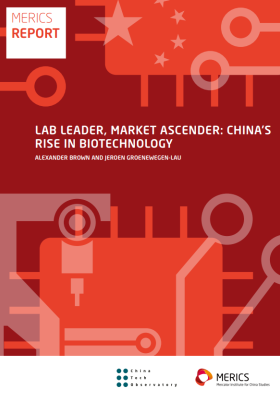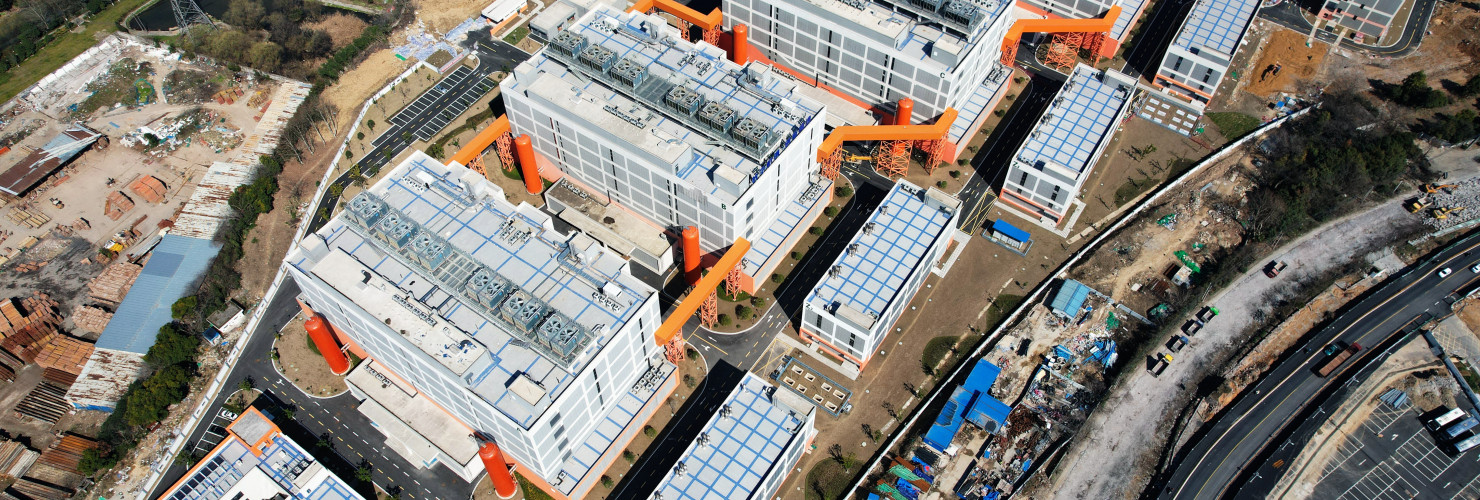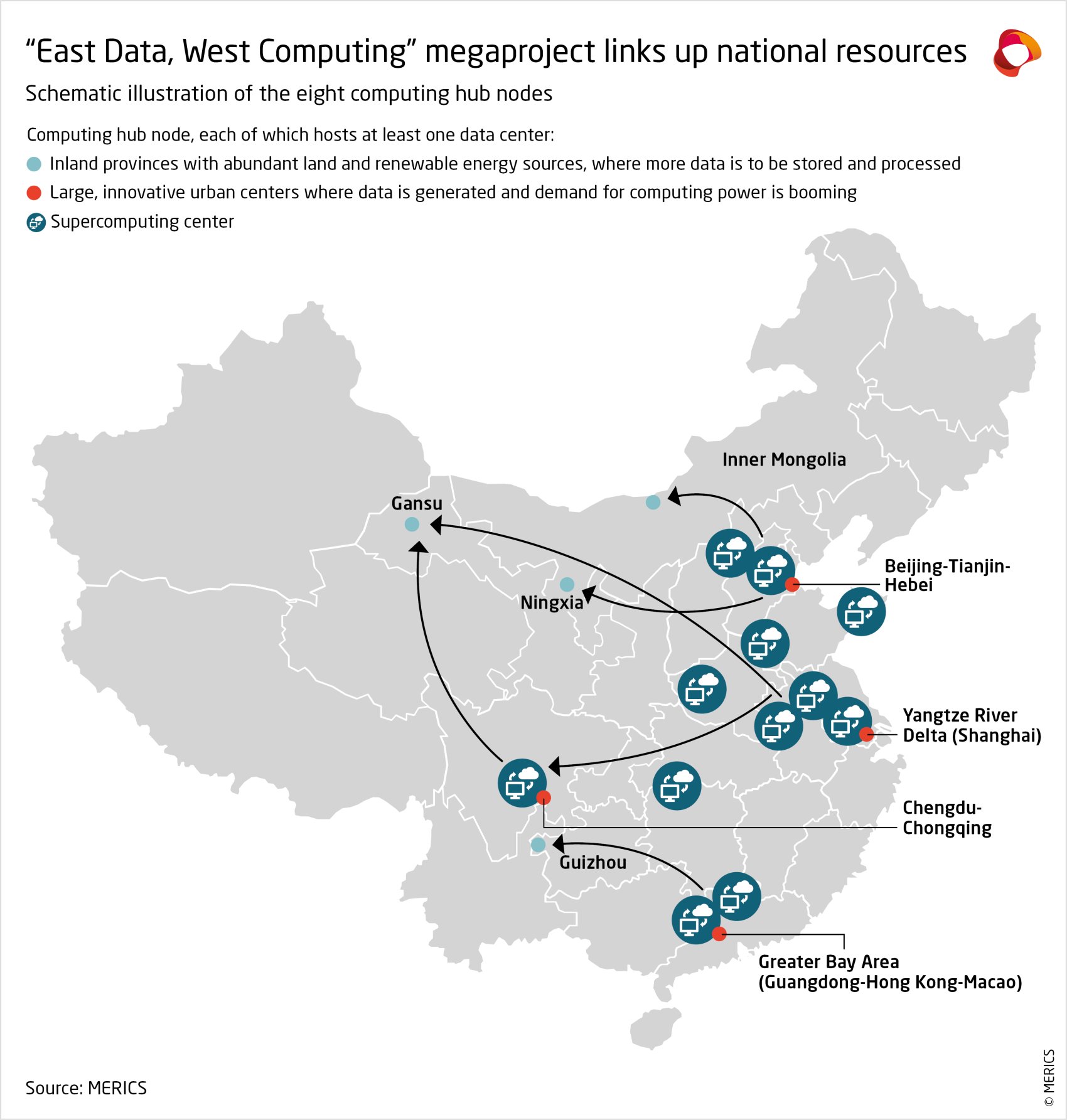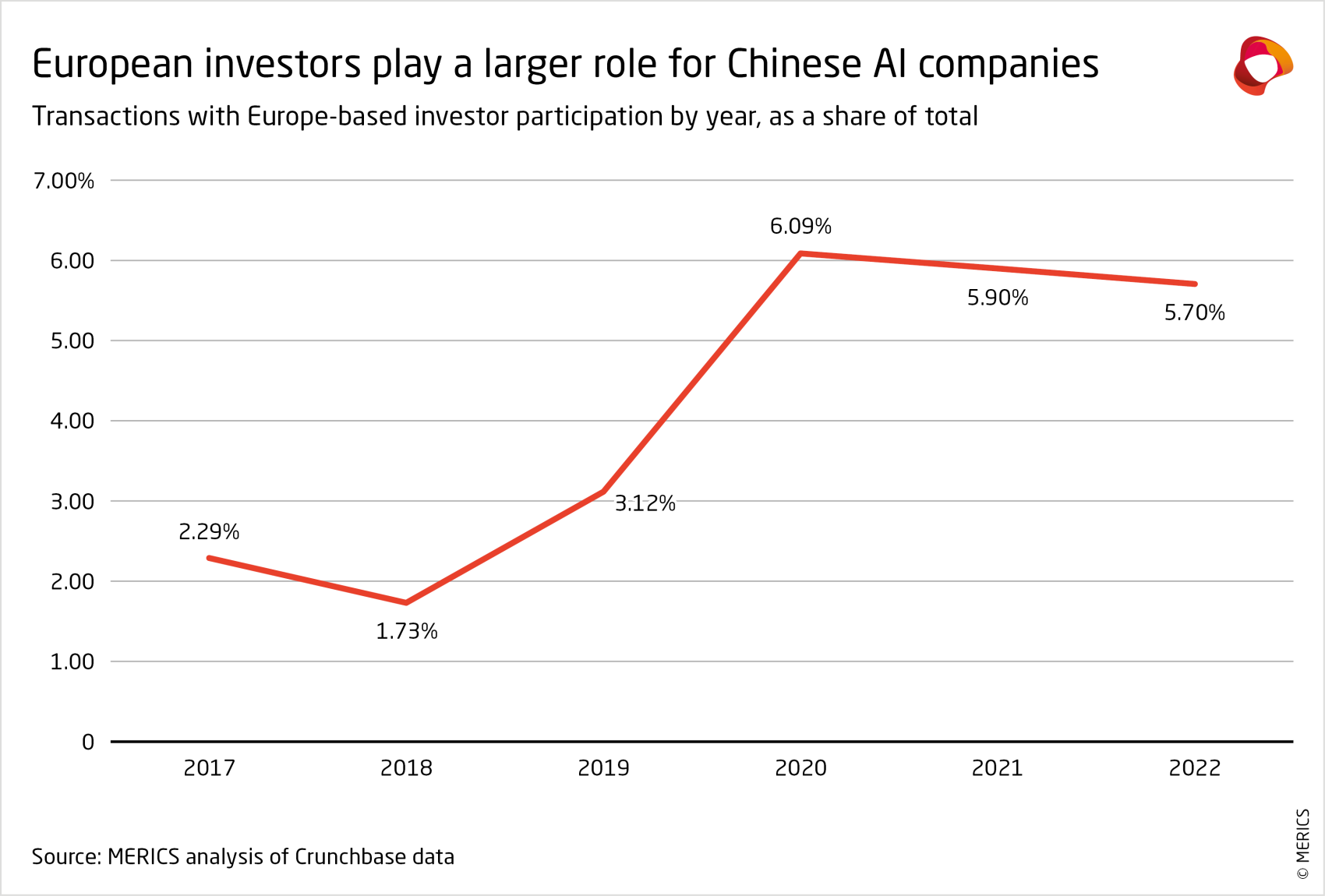

China’s AI development model in an era of technological deglobalization
As strategic rivalry between Beijing and Washington centers on new technologies, a trend towards decoupling and deglobalization is challenging the global links upon which China’s artificial intelligence (AI) sector has relied for a long time. This means that Beijing’s AI development strategy must contend with an erosion of global interdependencies. This policy brief examines three key elements of China’s response: an infrastructure megaproject for computing power, a “whole-of-nation” approach to developing AI foundation models, and efforts to forge connections with foreign innovation systems beyond the United States. None of these come without challenges.
 This brief is part of a special series organized jointly by the University of California Institute on Global Conflict and Cooperation (IGCC) and the Mercator Institute for China Studies (MERICS). This analysis was originally presented at the Conference on the Chinese National Innovation and Techno-Industrial Ecosystems in Berlin, September 5–6, 2023.
This brief is part of a special series organized jointly by the University of California Institute on Global Conflict and Cooperation (IGCC) and the Mercator Institute for China Studies (MERICS). This analysis was originally presented at the Conference on the Chinese National Innovation and Techno-Industrial Ecosystems in Berlin, September 5–6, 2023.
Key findings
- Technological decoupling is disentangling longstanding cross-border ties, particularly those between the Chinese and US AI ecosystems. Beijing is increasingly planning for self-reliance in AI technology, while pursuing integration with global innovation networks where possible and advantageous.
- Partly in response to US export controls on AI-relevant semiconductor technology, Chinese authorities are implementing an infrastructure megaproject that has led to several initiatives to organize China’s scarce computing resources more efficiently for AI model training. Coordination among different players will be key to avoiding fragmentation and wasteful investments.
- One such initiative is led by the state-backed Peng Cheng Lab (PCL). PCL embodies the government’s effort to invest in bringing different actors together, stimulating synergies to generate breakthroughs in “key and core technologies.” This “whole-of-nation” approach is apparent in initiatives to orchestrate partnerships and pool resources for training foundation models.
- By mobilizing state labs and tasking leading firms with building dedicated AI ecosystems, Beijing hopes to rally relevant actors around a nationwide mission. But China may find it challenging to reconcile state steering and market-led innovation.
- International collaboration in AI is coming to terms with growing restrictions on Chinese actors’ access to global resources. Next to hardware, Beijing worries about losing access to foreign capital and global software communities. New policies being considered by the US government may exacerbate this.
- Chinese actors will likely seek to forge partnerships for AI development beyond the United States. In Europe, AI collaboration with China is on the rise. China’s AI ecosystem is likely to maintain significant global connections for the time being, despite pressures for decoupling.
Introduction: A shift from collaboration to decoupling is reshaping the global AI landscape
Intense rivalry between China and the United States for dominance in emerging technologies is reshaping how both countries organize industrial and innovation policy. By seeking to curb China’s capabilities in advanced-node semiconductors and related equipment, advanced computing, and supercomputers through export controls enacted in October 2022 and updated one year later, the Biden administration aims to undermine Beijing’s AI ambitions.1,2 Geopolitical competition and deglobalization are challenging the global links upon which the Chinese AI innovation and techno-industrial ecosystems have long relied.
China’s AI development strategy, which was mainly set out in the State Council’s 2017 New Generation AI Development Plan (新一代人工智能发展规划), contends with a progressive erosion of global interdependencies. US tech giants have downsized or halted their AI research and development (R&D) in China. Smaller firms based elsewhere, like British AI chip startup Graphcore, have had to pull out of China due to US export controls.3,4 Moreover, Chinese AI firms have come under growing scrutiny in the West for their contributions to Beijing’s strategy of “military-civil fusion” (MCF, 军民融合) and state surveillance projects.5
While industry has sometimes resisted national security diktats, these developments have prompted China’s leaders to stand firm on goals of national “self-reliance and self-improvement” (自立自强) in science and technology (S&T) policy. These objectives are not new. The Chinese Communist Party (CCP) has traditionally viewed S&T through a national security-centric lens and has sought to promote indigenous innovation. However, US policies now make it a necessity for China to rely more on itself if it is to master such a strategic technology as AI.
This policy brief examines state efforts to improve AI infrastructure design and China’s “whole-of-nation” approach to developing large language models (LLMs) as two examples of how Chinese policymakers are adapting to a new global environment and the threat of being cut off from AI inputs. Drawing on recent research from the Mercator Institute for China Studies (MERICS), the brief also considers how China’s government and tech firms may seek to tap resources in foreign innovation systems beyond the United States.
This analysis is not meant as a comprehensive overview of China’s AI development strategy. Other aspects, such as workforce policy and government funding, are also significant. Rather, the following aims to shed light on three key ways in which China is adjusting to a deglobalizing AI world. Although evaluating their effectiveness may be premature, they provide a useful indication of how Beijing is planning for self-reliance in AI technology while selectively pursuing integration with global innovation networks where possible and advantageous.
China’s response to a deglobalizing AI world
A grand plan for computing infrastructure
Among the inputs that fuel China’s AI ecosystem—hardware, talent, data, and capital—US export restrictions impact hardware the most. In response, Chinese policymakers are nurturing domestic alternatives to American AI chips, such as Nvidia’s most advanced graphic processing units (GPUs). However, securing chips is not enough: government efforts to expand the national computing power network to optimize resource efficiency is an important and underexplored dimension of Chinese AI self-reliance.6 Beijing hopes to leverage China’s traditional strength in infrastructure to organize the enormous amounts of computing power required to train AI models. That is especially true for LLMs, such as the engine behind OpenAI’s ChatGPT.
One key piece of this effort is the National Integrated Computing Power Network (NICPN, 全国一体化算力网络), part of an infrastructure megaproject launched in 2021 by the National Development and Reform Commission (NDRC, 国家发展改革委员会) to optimize and integrate computing resources across the country.7 It is linked to a plan to have more data processed and stored in Western China, where land and electricity are cheaper.8 Recent policy documents highlight that computing power is among President Xi Jinping’s much touted “new productive forces” (新型生产力). Government sources call for resource pooling and collaborative scheduling to achieve efficiency without disproportionately driving up energy consumption.9
One key piece of the NICPN is the “China Computing Net” (C2NET, 中国算力网), spearheaded by the provincial government-owned Peng Cheng Lab (PCL, 鹏城实验室) in collaboration with Huawei. C2NET is intended as an interconnected grid of AI computing centers, data center clusters, and supercomputers which allocates computing power like a public utility. According to Gao Wen (高文), PCL’s director and an academic at the Chinese Academy of Engineering:
“In a few years, computing power will be like today’s electricity. Where it is does not matter: If you want to make calculations and receive computing power online, you can just pay and use it.”10
Descriptions of C2NET reveal its potential usefulness in the context of US export controls. The system combines different kinds of chips and optimizes hardware use.11 As such, C2NET will play an important role as Chinese AI developers strive to offset reduced access to the most advanced chips.12 For example, PCL’s infrastructure helped Huawei develop PanGu (盘古), a couple of large-scale pretrained language models powered by Huawei’s Ascend 910 processors.13 With Baidu, the lab also introduced a technique for collaboratively training deep learning models in the Cloud, which can reduce compute intensity.14
Central and local government bureaucracies as well as firms are coming up with similar initiatives, demonstrating the importance of infrastructure in China’s AI policy.15 The point of NICPN is to make the most of China’s available computing resources—both indigenous and from stockpiled US chips—by improving infrastructure design, which also mitigates the economic and energy costs of using less powerful equipment. Computing infrastructure was a prominent theme at the 2024 “Two Sessions,” the annual plenary meetings of the National People’s Congress and the Chinese People’s Political Consultative Conference (CPPCC), where AI’s role in the country’s industrial upgrading took central stage.
According to CPPCC delegate Zhang Yunquan (张云泉) of the Chinese Academy of Sciences Institute of Computing Technology (计算技术研究所):
“The battle of a hundred of models has led to an over-dispersion of computing resources, delaying the development of “sovereign-level foundation models.” Whether it is specialized supercomputing projects or AI chip breakthrough projects, the state needs to coordinate resources, forming teams in the manner of the historical “Two Bombs, One Satellite” to achieve rapid breakthroughs.”16
As of March 2023, over 30 Chinese cities were building or planning an intelligent computing center (智算中心) or infrastructure specifically designed to run AI workloads.17 Many are being spearheaded by private firms, like Alibaba or Sensetime, but state-owned firms like China Telecom are also active in this space.
It remains to be seen whether this megaproject, which authorities want to see up and running by 2025, will deliver the desired results. Regional disparities and deficiencies in coordination remain. The risk of bureaucratic infighting leading to fragmented and wasteful investments—as seen with several Chinese infrastructure initiatives in the past—should not be discounted. The head of the newly created National Data Administration (国家数据局), Liu Liehong (刘烈宏), urged local governments to avoid “blind and disorderly contruction” in an article penned for the Communist Party journal Qiushi.18
A whole-of-nation approach to developing foundation models
A closer look at PCL illustrates how the government is investing in platforms and support structures to bring AI actors together, stimulating the synergies required to generate breakthroughs in critical technologies.
PCL is a provincial research lab set up by the Guangdong and Shenzhen governments in 2018 to pool resources and drive advanced research, with a increasing focus on large pretrained models. Chinese firms and labs are rushing to develop their own foundation models, with 79 such models having already emerged by May 2023.19 Many more have since followed, often built on top of Silicon Valley architectures like Meta’s LLaMA and released as open source models. Training AI models is extremely compute intensive, which—especially for startups—can make costs prohibitive as advanced chips become more scarce due to US restrictions.
By providing the infrastructure and platforms required for ambitious projects like LLM training, PCL states on its website that it implements the “new-style whole-of-nation system for tackling key and core technologies” (关键核心技术攻关新型举国体制).20 An English-language review of Chinese LLMs from April 2023 found that government-sponsored labs like PCL have provided crucial support by pooling talent, funding, and resources from government, industry, and academia.21 This function of public service platforms is at the core of PCL’s mandate as a “New Research and Development Institutes” (NRDI, 新型研发机构), a batch of institutions tasked with spurring breakthroughs in new technologies and facilitating linkages between labs and the market. Notably, PCL recently received a high-level visit by Chinese Vice Premier Ding Xuexiang, suggesting its growing importance amid S&T competition with the United States.22
The whole-of-nation approach is a policy concept with deep historical roots, which President Xi has revisited to have the state play a greater role in steering market actors to produce breakthroughs in strategic areas like AI.23 A key step is to bring the leading national actors together to jointly find solutions to challenges that Chinese leadership has identified as priorities. For AI, this approach to managing state-market relations has precedent in the “national team” (国家队) concept that was launched in 2017 and subsequently expanded. The government selects leading AI firms to build ecosystems in specific areas and set standards.24 In July 2023, Baidu, Huawei, Qihoo 360, China Mobile, iFlytek, and Alibaba were chosen to drive the development of national standards for LLMs under the leadership of Shanghai AI Lab (上海人工智能实验室).25
In this approach, the government acts like an ecosystem orchestrator. Chinese LLM developers—especially small and medium enterprises—receive government subsidies to grow their computing resources, and are also supported in other ways.26 For example, the Beijing municipality promotes resource pooling among select firms and labs through a partnership plan for “artificial general intelligence” (AGI, 通用人工智能), which includes an open cooperation platform for AI large models.27 The local government is also promoting real-world applications and selectively opening public datasets for model training, while expecting capable firms to share their computing power, technology, and other resources.
By mobilizing state labs like PCL and tasking leading firms with building dedicated ecosystems for AI, policymakers hope to rally relevant actors around a nationwide mission. To get industry buy-in, in the summer of 2023 the powerful Cyberspace Administration of China (CAC, 国家互联网信息办公室) partly relaxed the regulatory burden it intended to place on generative AI developers, likely to support domestic innovators amid intense geopolitical competition.28
Whether firms will set competition aside to share their resources and help smaller players remains to be seen. There is an inherent tension between state steering and the promotion of bottom-up, market-led innovation which may prove challenging to reconcile. Still, policymakers seem to trust the whole-of-nation system to give China the upper hand in AI. The fact that Chinese firms are losing access to global resources adds urgency to this project, but complicates its execution.
Seeking non-US partners in AI development: The view from Europe
Like other nations, China has greatly benefited from the global networks that provide the inputs for AI development. As Jeffrey Ding, a scholar of Chinese technology and AI policy, has argued, given the general-purpose nature of AI, favoring open information flows across borders would be in China’s interest.29 In practice, however, international collaboration in AI is coming to terms with growing restrictions on Chinese actors’ access to global resources. Next to hardware, Beijing worries about losing access to foreign capital as well as global software-development and R&D communities.
In terms of capital, MERICS found that Europe-based investors contributed to 3.7 percent of investment transactions into Chinese AI companies between 2017 and 2022.30 For comparison, experts at the Center for Security and Emerging Technology found that US investors participated in 17 percent of such transactions between 2015 and 2021. China’s AI industry relies predominantly on domestic capital.31
This suggests that government measures to restrict foreign investment into China’s AI ecosystem would not significantly impact financing. But the numbers above are not trivial, because these investors often bring intangibles such as managerial expertise or know-how tied to forging technology partnerships with foreign corporates.32 This impression is supported by Beijing’s efforts to welcome foreign involvement in both private equity and tech-focused stock markets in its drive to nurture indigenous innovation.33
The measures being considered as part of the Biden administration’s proposed outbound investment screening program take aim at the kind of “smart” capital China’s government seeks to attract, which is tied to intangibles such as access to talent networks and expertise.34 In February, the European Commission proposed a somewhat similar monitoring program of certain transactions by European investors, which starts with gathering data to assess risks and evaluate the need for policy responses.35
Arguably, losing access to the global R&D ecosystems underpinning AI innovation would have a much bigger impact than losing access to capital, considering China’s enduring reliance on US frameworks for deep learning, such as TensorFlow, Pytorch, and Meta’s LLaMA.36 One longstanding concern among Chinese technologists and policymakers is that US export controls may expand to cover open-source software. In anticipation, the government has stepped up support for domestic open-source software communities like Gitee and frameworks like Baidu’s PaddlePaddle (飞桨) and Huawei’s MindSpore, as a key ingredient of its AI development strategy.37 PCL’s own open-source LLM, PengCheng Mind (鹏城脑海), is based on MindSpore.
Although an expansion of US export controls on open-source AI software seems unlikely, Congress is pressuring the administration to bar Chinese entities’ participation in projects related to open-source chip design architecture RISC-V, which is becoming relevant for AI processors.38,39 The US Department of Commerce is reportedly assessing options for limiting access to the most powerful AI models by designated foreign actors. Furthermore, geopolitical tensions have begun to affect AI research collaboration as more and more Chinese scientists leave the United States.40 Talent flows and people-to-people exchanges have been the backbone of innovation in the global AI industry.
Against this backdrop, it is plausible that Chinese actors will seek to tap resources and forge partnerships for AI development beyond the United States. Some of China’s top AI research partners are European nations, notably the United Kingdom, as well as Germany and France.41 MERICS research found that Chinese coauthors are more likely to initiate collaborations and that disclosed funding for European-Chinese coauthored papers in AI comes from the Chinese government in 60 percent of cases.42 Moreover, while Chinese investment into the European AI sector still appears limited, it has increased since 2017. For example, Lenovo Group, partly owned by the Chinese Academy of Sciences, was the sole investor in a Series A funding round for a German startup dedicated to developing LLMs.43
To be sure, there is no substitute for US AI research and industry jaggernauts. Decoupling from the American AI ecosystem will most certainly hit China’s AI development. But the direction of travel is clear. In the long term, China will have to rely more on itself and non-US partners. A recent study by MacroPolo found that by some metrics the country has already surpassed the United States as a supplier of the world’s best AI talent.44 Forging the right connections with willing partners may also prove key to the resilience of China’s AI sector.
Policy implications
Questions abound regarding the future impact of US government restrictions on China’s AI ecosystem. Sidestepping them will not be easy. In October 2023, the US Department of Commerce updated restrictions on China’s access to US and allied semiconductor technology, including by adjusting the parameters of covered chips to include more products—like Nvidia’s A800 and H800 chips—and placing additional limits on the export of various semiconductor manufacturing equipment to China. The department has also been mulling restrictions on Chinese firms’ access to advanced semiconductor technology via Cloud service providers.45 Still, Huawei’s recent return to the 5G smartphone business showed that US export controls have significant loopholes and do not always achieve their desired outcomes.46
Meanwhile, Chinese actors’ outreach to other countries and regions merits attention, particularly when it comes to allied policy coordination on de-risking. Washington is worried that Chinese tech firms may access AI-enabling chips via other countries. In August 2023, the US government began restricting exports of certain Nvidia and AMD chips to some Middle Eastern countries, apparenly motivated by the growing AI research collaboration between universities in China and Saudi Arabia.47 The policy was formalized in October 2023 with new anti-circumvention measures, which extended licensing requirements for advanced semiconductor tech exports to an additional 43 countries. The extraterritorial reach of US authorities—or the threat thereof—is already making life difficult for Chinese firms abroad, with some companies being forced to choose between Chinese and US partners.48
Conclusion
Regardless of the success prospects for China’s technology acquisition and indigenization efforts, China’s AI development policy is highly focused on improving infrastructure design and concentrating resources to cope with the challenges of US restrictions. While it is setting up safeguards and aiming for self-reliance with its whole-of-nation approach, China also seeks to remain connected with global innovation communities in highly globalized technology industries like AI.
Many US allies and partners, for their part, will want to carefully evaluate their de-risking strategies with respect to complex entanglements with China in critical and emerging technology fields.49 In Europe, despite growing concerns surrounding China-related challenges to research and technology security, there is limited appetite for radical restrictions on cross-border research and innovation. Tellingly, even some US tech giants are determined to continue reaping the benefits of China’s AI boom.50 This means that China’s AI ecosystem is likely to maintain significant global connections for the time being, despite pressure for decoupling.
- Endnotes
-
1 | Thomas J. McCarthy, Kevin J. Wolf, et al., “BIS Imposes New Controls to Limit the Development and Production of Advanced Computing and Semiconductor Capabilities in China,” Akingump, October 27, 2022, https://www.akingump.com/en/news-insights/bis-imposes-new-controls-to-limit-the-development-and-production-of-advanced-computing-and-semiconductor-capabilities-in-china.html; “Implementation of additional export controls: certain advanced computing and semiconductor manufacturing items; supercomputer and semiconductor end use; entity list modification,” Federal Register, October 13, 2022, https://www.federalregister.gov/documents/2022/10/13/2022-21658/implementation-of-additional-export-controls-certain-advanced-computing-and-semiconductor.
2 | “Implementation of Additional Export Controls: Certain Advanced Computing Items; Supercomputer and Semiconductor End Use; Updates and Corrections,” Federal Register, October 25, 2023, https://www.federalregister.gov/documents/2023/10/25/2023-23055/implementation-of-additional-export-controls-certain-advanced-computing-items-supercomputer-and.
3 | Graham Webster, Rogier Creemers, Elsa Kania and Paul Triolo, “Full Translation: China’s ‘New Generation Artificial Intelligence Development Plan’ (2017) - DigiChina,” DigiChina, October 1, 2021, https://digichina.stanford.edu/work/full-translation-chinas-new-generation-artificial-intelligence-development-plan-2017/.
4 | “IBM Closes China Research Laboratory,” Synced, January 25, 2021, https://syncedreview.com/2021/01/25/ibm-closes-china-research-laboratory/; Karen Weise, Cade Metz, and David McCabe, “Microsoft Debates What to Do With A.I. Lab in China,” The New York Times, January 10, 2024, https://www.nytimes.com/2024/01/10/technology/microsoft-china-ai-lab.html; Georgia Butler, “Chipmaker Graphcore Pulls Out of China,” DCD, November 24, 2023, https://www.datacenterdynamics.com/en/news/chipmaker-graphcore-pulls-out-of-china/.
5 | Will Knight, “MIT Cuts Ties With a Chinese AI Firm Amid Human Rights Concerns,” WIRED, April 21, 2020, https://www.wired.com/story/mit-cuts-ties-chinese-ai-firm-human-rights/.
6 | “工信部:计划出台推动算力基础设施发展政策,加强GPU等重点产品研发 (Ministry of Industry and Information Technology: plans to introduce policies to promote the development of arithmetic infrastructure and strengthen the research and development of key products such as GPUs),” The Paper, July 17, 2023, https://m.thepaper.cn/newsDetail_forward_23880459; “夯实AI新型基础设施 加快科技自立自强步伐 (Strengthen new-style AI infrastructure and accelerate the pace of scientific and technological self-reliance and self-improvement),” ScienceNet, February 6, 20213, http://finance.people.com.cn/n1/2023/0206/c1004-32618538.html.
7 | “一图读懂 | 全国一体化算力网络国家枢纽节点怎么建? (How to build a national hub node of the national integrated computing power network?),” National Development and Reform Commission, May 26, 2023, https://www.gov.cn/xinwen/2021-05/26/content_5612631.htm.
8 | Jeroen Groenewegen-Lau, “Oceans of Data Lift All Boats: China’s Data Centers Move West,” MERICS, July 6, 2022, https://merics.org/en/comment/oceans-data-lift-all-boats-chinas-data-centers-move-west.
9 | “算力基础设施高质量发展行动计划 (Action Plan for the Quality Development of Computing Infrastructure),” Ministry of Industry and Information Technology, October 10, 2023, https://perma.cc/5BUT-AF5P; “国家发展改革委等部门关于深入实施“东数西算”工程加快构建全国一体化算力网的实施意见 (Implementing Opinions of The National Development and Reform Commission and Other Departments Regarding Deepening The Implementation of The “Eastern Data, Western Computing” Project and Accelerating The Construction of The National Integrated Computing Power Network),” National Development and Reform Commission, December 25, 2023, https://www.ndrc.gov.cn/xxgk/zcfb/tz/202312/t20231229_1363000.html.
10 | “‘中国算力网—智算网络’上线 算力网络建设迈出关键一步 (‘China Computing Net - Smart computing Network’ went online, a key step in the construction of the computing power network),” Xinhua News, June 20, 2022, http://www.news.cn/info/20220620/05a072e8bf444006baf158899e393e02/c.html; “中国工程院院士高文:算力会像电力一样随时使用 (Gao Wen, member of the Chinese Academy of Engineering: computing power will be readily available like electricity),” Sohu, August 8, 2022, https://www.sohu.com/a/575010629_119038.
11 | Wen Gao (高文), “中国算力网的机遇与挑战 (Opportunities and challenges of China Computing Net),” China Computer Federation 19, no. 1, Janurary 28, 2023, https://archive.is/Of4ks.
12 | Karen Hao and Raffaele Huang, “U.S. Sanctions Drive Chinese Firms to Advance AI Without Latest Chips,” The Wall Street Journal, May 7, 2023, https://www.wsj.com/amp/articles/u-s-sanctions-drive-chinese-firms-to-advance-ai-without-latest-chips-f6aed67f.
13 | Instead of being trained from scratch, a pretrained AI model is a deep learning model that was previously trained on large datasets to accomplish a specific task, and can be either used as is or finetuned to meet specific application requirements.
14 | Jeffrey Ding, “ChinAI #141: The PanGu Origin Story,” ChinAI Newsletter, May 17, 2021, https://chinai.substack.com/p/chinai-141-the-pangu-origin-story; Wei Zeng et al., “PanGu-α: Large-Scale Autoregressive Pretrained Chinese Language Models with Auto-Parallel Computation,” Cornell University, April 26, 2021, https://arxiv.org/abs/2104.12369; “鹏城实验室和百度联合发布面向云际环境的深度学习统一训练框架’鹏城-百度·星云(Nebula-I)’ (Pengcheng Labs and Baidu jointly release ‘Pengcheng-Baidu-Nebula-I,’ a unified deep learning training framework for intercloud environments),” Pengcheng Laboratory, May 25, 2022, https://archive.is/gpk41; Yang Xiang et al., “Nebula-I: A General Framework for Collaboratively Training Deep Learning Models on Low-Bandwidth Cloud Clusters,” Cornell University, May 19, 2022, https://arxiv.org/abs/2205.09470.
15 | “全国一体化超级智能算力调度平台 (National Integrated Supercomputing Power Scheduling Platform),” China Arithmetic, accessed April 8, 2024,https://suanlicn.com/index.html.
16 | “全国政协委员张云泉:整合战略资源构建主权级基础大模型 (Zhang Yunquan, member of the National Committee of the Chinese People’s Political Consultative Conference (CPPCC): Integrating strategic resources to build sovereign-level foundation models),” Sohu News, March 7, 2024, https://www.sohu.com/a/762511716_425761.
17 | Force Distance Times, “Nvidia Wants ‘AI Factories.’ China Is Building Lots of Them,” A/Symmetric, March 23, 2024, https://theasymmetric.substack.com/p/nvidia-china-ai-factories-computing-centers.
18 | Liu, Lielong (刘烈宏), “加快构建全国一体化算力网 推动建设中国式现代化数字基座 (Accelerating the construction of a national integrated computing power network and promoting the construction of a Chinese-style modernized digital foundation),” Qiushi, March 16, 2024, http://www.qstheory.cn/dukan/qs/2024-03/16/c_1130089697.htm.
19 | “AI大模型’国家队’定了 (AI Large Model ’National Team’ is set),” Cbdio, July 12, 2023, http://www.cbdio.com/BigData/2023-07/12/content_6174264.htm.
20 | “鹏城实验室概况 (Profile of Pengcheng Laboratory),” Pengcheng Laboratory, https://archive.is/0F7vk.
21 | Jeffrey Ding and Jenny Xiao, “Recent Trends in China’s Large Language Model Landscape,” Center for the Governance of AI, April 28, 2023, https://www.governance.ai/research-paper/recent-trends-chinas-llm-landscape.
22 | CCTV News, “丁薛祥在广东深圳调研 (Ding Xuexiang conducts an inspection in Shenzhen, Guangdong),” Pengcheng Laboratory, October 16, 2023, https://pcl.ac.cn/html/897/2023-10-16/content-4315.html.
23 | Jeroen Groenewegen-Lau, Whole-of-nation Innovation: Does China’s Socialist System Give It an Edge in Science and Technology?, MERICS and IGCC report, March 5, 2024, https://merics.org/en/report/whole-nation-innovation-does-chinas-socialist-system-give-it-edge-science-and-technology; “健全关键核心技术攻关新型举国体制 全面加强资源节约工作 (Improving a new-style whole-of-nation system for tackling key and core technologies, and comprehensively strengthening resource conservation efforts),” People’s Daily, September 7, 2022, http://politics.people.com.cn/n1/2022/0907/c1024-32520882.html.
24 | Benjamin Larsen, “Drafting China’s National AI Team for Governance,” DigiChina, October 14, 2021, https://digichina.stanford.edu/work/drafting-chinas-national-ai-team-for-governance/.
25 | “AI大模型’国家队’定了 (AI Large Model ’National Team’ is set),” Cbdio, July 12, 2023, http://www.cbdio.com/BigData/2023-07/12/content_6174264.htm; “委员企业 | 上海人工智能实验室当选国家人工智能标准化总体组大模型专题组组长 (Member enterprises | Shanghai AI Lab was selected to lead the large model special group of the National Artificial Intelligence Standardization Group),” The Paper, July 13, 2023, https://www.thepaper.cn/newsDetail_forward_23861576.
26 | “AI‘模都’来了!上海发布大模型政策 重点支持研发具有国际竞争力的大模型 (‘AI model capital’ is coming! Shanghai releases large model policy, focusing on supporting R&D of internationally competitive large models),” Securities Times, July 8, 2023, https://www.stcn.com/article/detail/914049.html.
27 | “大模型看北京!2023全球数字经济大会人工智能高峰论坛成功举办 (Look at Beijing’s large models! 2023 Global Digital Economy Conference Artificial Intelligence Summit successfully held),” The People’s Government of Beijing Municipality, July 4, 2023, https://www.beijing.gov.cn/fuwu/lqfw/ztzl/gdec2023/qyjs/202307/t20230704_3154181.html.
28 | Rebecca Arcesati and Vincent Brussee, “China’s Censors Back Down on Generative AI,” The Diplomat, August 7, 2023, https://thediplomat.com/2023/08/chinas-censors-back-down-on-generative-ai/.
29 | Jeffrey Ding, Techno-Industrial Policy for New Infrastructure: China’s Approach to Promoting Artificial Intelligence as a General Purpose Technology, IGCC working paper, December 2022, https://ucigcc.org/wp-content/uploads/2022/12/Ding_working-paper_IGCC-2022-1.pdf.
30 | MERICS analysis of Crunchbase data on the investment rounds of Chinese AI companies, limited to investment transactions involving investors domiciled in either the EU, the UK, Switzerland, or Norway and completed between 2017 and 2022. European investors contributed to 81 of 2165 such transactions within this timeframe. Importantly, a single transaction may involve investors from multiple countries and regions and the exact capital contribution of each individual investor is not known. Crunchbase, 2023, https://www.crunchbase.com/, accessed June 2023. For more information, see Rebecca Arcesati, Wendy Chang, Antonia Hmaidi, and Kai von Carnap, AI entanglements: Balancing risks and rewards of European-Chinese collaboration, MERICS report, November 16, 2023, https://merics.org/en/report/ai-entanglements-balancing-risks-and-rewards-european-chinese-collaboration.
31 | Emily S. Weinstein and Ngor Luong, U.S. Outbound Investment into Chinese AI Companies, Center for Security and Emerging Technology (CSET) policy brief, February 2023, https://cset.georgetown.edu/publication/u-s-outbound-investment-into-chinese-ai-companies/.
32 | Ibid.
33 | Ngor Luong, How the Chinese government is financing its way to becoming a techno-superpower, Atlantic Council issue brief, November 28, 2022, https://www.atlanticcouncil.org/in-depth-research-reports/issue-brief/how-the-chinese-government-is-financing-its-way-to-becoming-a-techno-superpower/.
34 | “President Biden Signs Executive Order on Addressing United States Investments In Certain National Security Technologies And Products In Countries Of Concern,” The White House, August 9, 2023, https://www.whitehouse.gov/briefing-room/statements-releases/2023/08/09/president-biden-signs-executive-order-on-addressing-united-states-investments-in-certain-national-security-technologies-and-products-in-countries-of-concern/.
35 | “Monitoring and risk assessment of outbound investment,” European Commission, 24 January 2024, https://policy.trade.ec.europa.eu/consultations/monitoring-and-risk-assessment-outbound-investment_en.
36 | Kate Kaye, “Will nationalism end the golden age of global AI collaboration?” Protocol, November 1, 2022, https://www.protocol.com/enterprise/china-us-ai-open-source, accessed June 10, 2023; Paul Mozur, John Liu, and Cade Metz, “China’s Rush to Dominate A.I. Comes With a Twist: It Depends on U.S. Technology,” The New York Times, February 21, 2024, https://www.nytimes.com/2024/02/21/technology/china-united-states-artificial-intelligence.html.
37 | Rebecca Arcesati and Caroline Meinhardt, China bets on open-source technologies to boost domestic innovation, MERICS report, May 19, 2021, https://merics.org/en/report/china-bets-open-source-technologies-boost-domestic-innovation; Jeffrey Ding, Techno-Industrial Policy for New Infrastructure: China’s Approach to Promoting Artificial Intelligence as a General Purpose Technology, IGCC working paper, December 2022, https://ucigcc.org/wp-content/uploads/2022/12/Ding_working-paper_IGCC-2022-1.pdf.
38 | “Understanding US Export Controls and Open Source Projects (2021 Update),” The Linux Foundation, 15 July 2021, https://www.linuxfoundation.org/blog/blog/understanding-us-export-controls-and-open-source-projects-2021-update.
39 | Don Clark and Ana Swanson, “The Next Front in the U.S.-China Battle Over Chips,” The New York Times, January 10, 2024, https://www.nytimes.com/2024/01/10/technology/risc-v-china-united-states-chips-security.html; “平头哥发布首个自研RISC-V AI平台 角逐高算力多领域展开规模化落地 (Pingtou Semiconductor releases first self-developed RISC-V AI platform to compete for large-scale implementation of high computing power in multiple fields)”, SCTN, August 23, 2023, https://www.stcn.com/article/detail/956545.html.
40 | Kate Kaye, “US policymakers could be alienating the Chinese AI researchers they want to attract,” Protocol, November 2, 2022, https://www.protocol.com/enterprise/us-china-ai-researchers-talent., accessed June 10, 2023; Christina Lu and Anusha Rathi, “Chinese Scientists Are Leaving the United States,” Foreign Policy, July 13, 2023, https://foreignpolicy.com/2023/07/13/chinese-scientists-united-states-research-tech-academia-china-initiative/.
41 | Emerging Technology Observatory’s Country Activity Tracker: Artificial Intelligence, Center for Security and Emerging Technology (CSET), https://cat.eto.tech/, accessed June 2023.
42 | MERICS analysis of OpenAlex data. OpenAlex. https://openalex.org/, accessed May 2023. For more information, see Rebecca Arcesati, Wendy Chang, Antonia Hmaidi and Kai von Carnap, AI entanglements: Balancing risks and rewards of European-Chinese collaboration, MERICS report, November 16, 2023, https://merics.org/en/report/ai-entanglements-balancing-risks-and-rewards-european-chinese-collaboration.
43 | Ibid.
44 | The Global AI Talent Tracker 2.0, MacroPolo, https://macropolo.org/digital-projects/the-global-ai-talent-tracker/, accessed April 8, 2024.
45 | “Implementation of Additional Export Controls: Certain Advanced Computing Items; Supercomputer and Semiconductor End Use; Updates and Corrections,” Bureau of Industry and Security, October 25, 2023, https://www.regulations.gov/document/BIS-2022-0025-0052.
46 | Ana Swanson, “Huawei Phone Is Latest Shot Fired in the U.S.-China Tech War,” The New York Times, https://www.nytimes.com/2023/09/06/business/economy/huawei-phone-us-china-raimondo.html.
47 | Stephen Nellis and Max A. Cherney, “US curbs AI chip exports from Nvidia and AMD to some Middle East countries,” Reuters, August 31, 2023, https://www.reuters.com/technology/us-restricts-exports-some-nvidia-chips-middle-east-countries-filing-2023-08-30/; Simeon Kerr, Samer Al-Atrush, Qianer Liu and Madhumita Murgia, “Saudi-China collaboration raises concerns about access to AI chips,” Financial Times, October 9, 2023, https://www.ft.com/content/2a636cee-b0d2-45c2-a815-11ca32371763.
48 | Chloe Cornish and Kaye Wiggins, “Abu Dhabi AI group G42 sells its China stakes to appease US,” Financial Times, February 9, 2024, https://www.ft.com/content/82473ec4-fa7a-43f2-897c-ceb9b10ffd7a.
49 | “Commission recommends carrying out risk assessments on four critical technology areas: advanced semiconductors, artificial intelligence, quantum, biotechnologies,” European Commission, October 3, 2023, https://ec.europa.eu/commission/presscorner/detail/en/ip_23_4735.
50 | Ben Jiang, “Intel’s new Chinese chip innovation centre is a collaboration with a Shenzhen district, deepening ties amid US scrutiny,” South China Morning Post, July 31, 2023, https://www.scmp.com/tech/big-tech/article/3229471/intels-new-chinese-chip-innovation-centre-collaboration-shenzhen-district-deepening-ties-amid-us.



